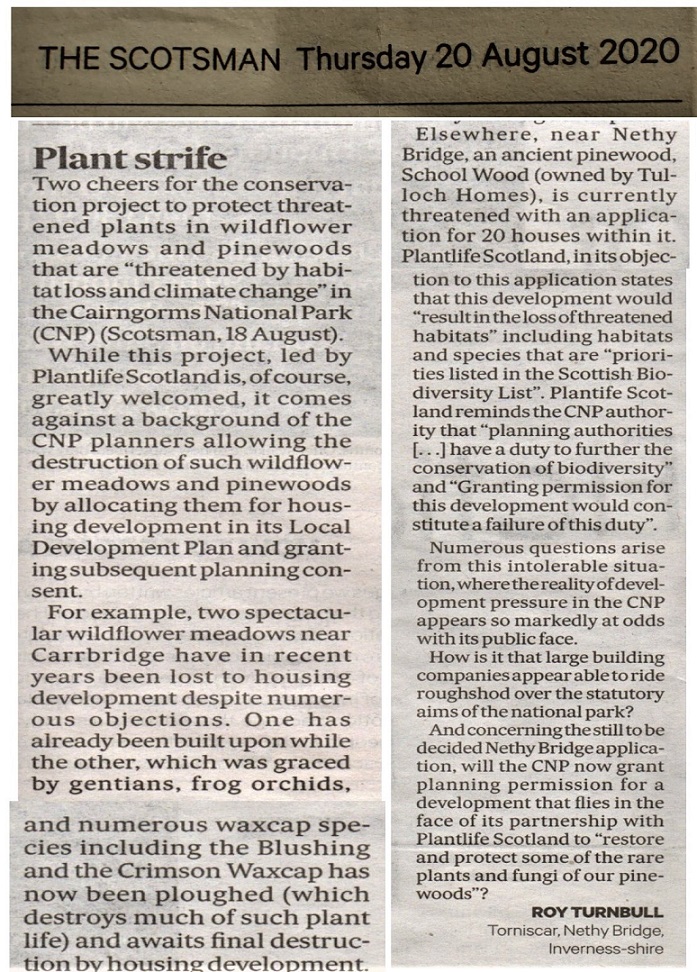
In the same week that Plantlife Scotland, with the support of the Cairngorms National Park Authority, launched this new scheme that hopes to “restore and protect some of the rare plants and fungi of our pinewoods, meadows and mountains” and, on the same day my letter appeared in the Scotsman, CNPA’s planners published their report (see here) into the application for 20 new houses in School Wood (see here for analysis on parkswatch in April).
The Planners’ Report acknowledges that,
- “The CNPA Ecology Officer advises that the site comprises a semi-natural woodland habitat of high ecological value and the features present within the site indicate that the woodland is a rich and complex resource.”
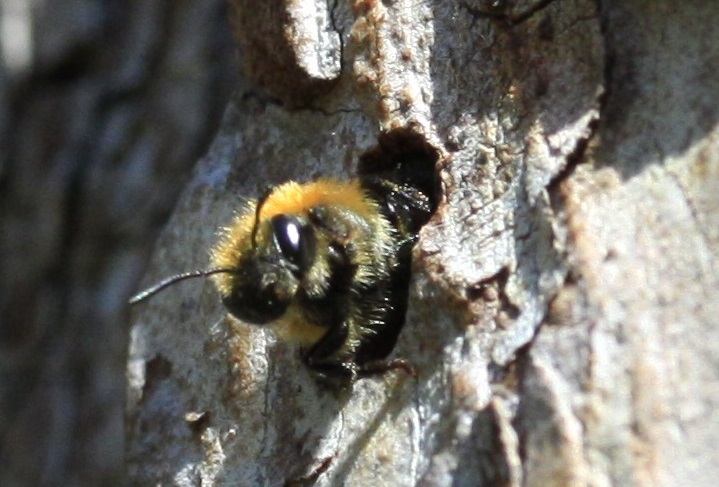
- “CNPA Landscape Officer considers that the proposal will result in a significant change to the landscape character of the site. This will be an adverse effect …”.
- “It is widely accepted that the loss of ancient woodland is considered irreplaceable and therefore compensation for loss of this resource is not possible.”
It is also, of course, the case that Scottish Planning Policy 2014 states:
- Ancient semi-natural woodland is an irreplaceable resource and […] should be protected from adverse impacts resulting from development.
And, the Cairngorms National Park Forest Strategy, 2018 states:
“The woodlands of the Cairngorms are of national and international importance because they contain the largest remaining areas of semi-natural woodland habitats in Britain!” and the Strategy undertakes to “Continue to protect ancient and semi-natural woodlands from further damage and fragmentation.”
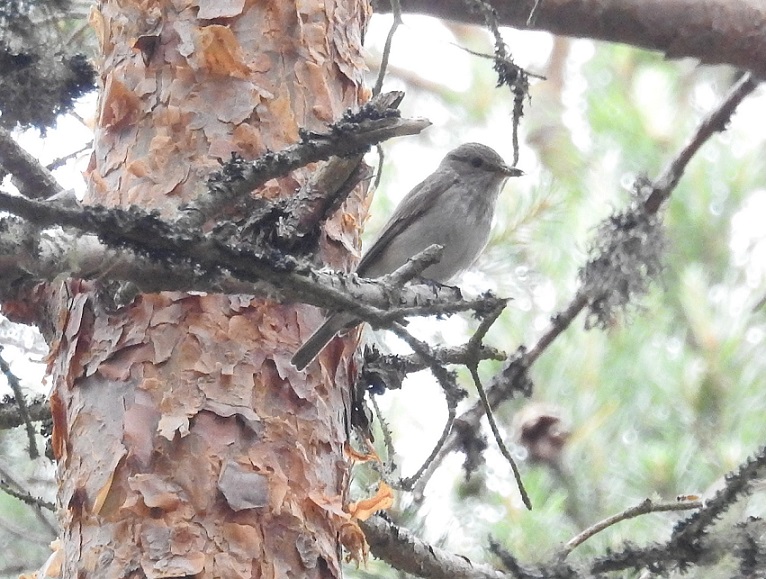
So, surely the answer to the question posed in my Scotsman letter, “will the CNP now grant planning permission” for the 20 houses in School Wood should be a resounding “No”!
How could any national park worthy of the name even consider turning part of an ancient pinewood of high ecological value into a housing estate!
But the CNPA planners have resorted to a ruse that they first tried earlier this year for a nearby woodland (by Lettoch Road). CNPA planners argue that, if granted planning permission, the applicant would undertake to manage the remaining woodland better, so that (they claim) there would be an overall conservation gain that could not otherwise be achieved!
Whilst that claim is already extremely dubious in itself, it ignores two important points that are not considered at all in the Report.
Firstly, if planning consent is refused, the present landowner, Tulloch Homes, would have no further interest in the wood and would probably sell. No other property developer would be interested and thus the wood would likely end up with a new owner interested in sensitively managing the woodland. So, a much greater conservation gain would result.
Secondly, the CNPA planners’ ruse could reward any landowner who has allowed any damaging activity such as fly-tipping or serious overgrazing to occur. “Present us with a damaged/neglected/trashed bit of land”, say the CNPA planners, “and behold! we will grant your planning application if you promise to improve the bit left over from your building site!”
It is not difficult to see what the overall effect of such a misguided ruse would be, where landowners throughout the national park would know that neglecting and abusing their land would improve their chance of obtaining planning consent from the CNPA.
Fortunately, there is still hope. The CNPA Planning Committee will make the final decision on 28th August, and when this same ruse was suggested, at Lettoch Road, the Committee made the brave and very welcome decision to refuse planning consent. Moreover, when the applicant then appealed to Scottish Government Reporters, his appeal was dismissed.
So, if the Committee refuse consent in School Wood, it is likely that any appeal would also be unsuccessful, particularly as the new Local Development Plan, which would then be in force, is expected to have no allocation for housing in School Wood.
All members of the CNPA Board are on the Planning Committee so, if you live in the National Park, please let your directly elected local representatives and councillors who serve on the Board know your views. You can find their names (click on their names to email them) here.
And for readers who don’t know the wood to get an idea of what’s at stake, here are a few more of the plants and animals that have been photographed there by the Badenoch and Strathspey Conservation Group………………
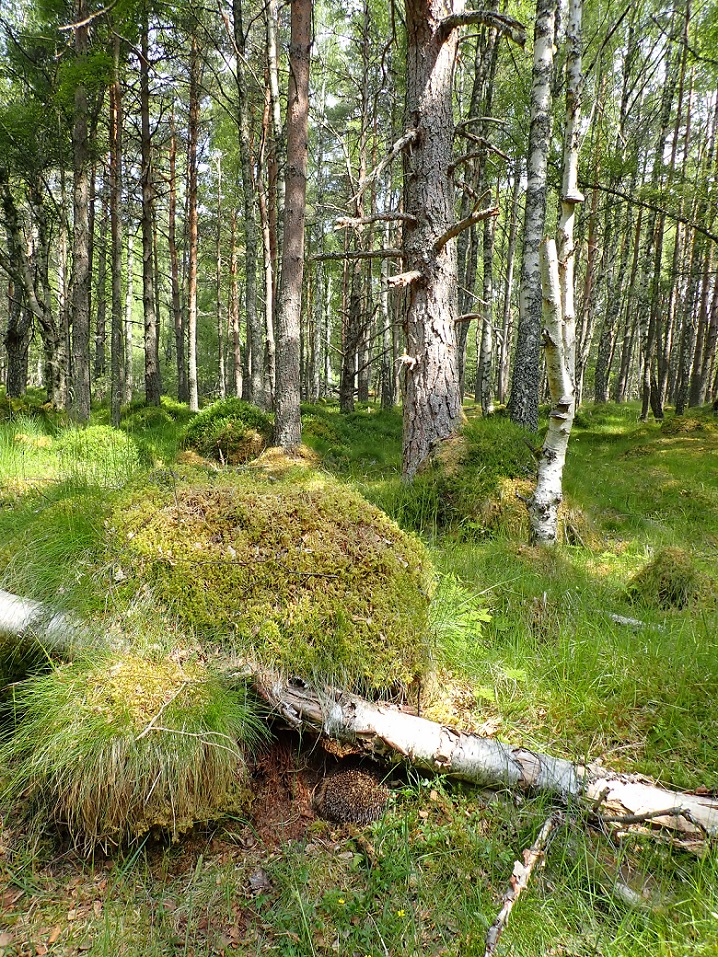
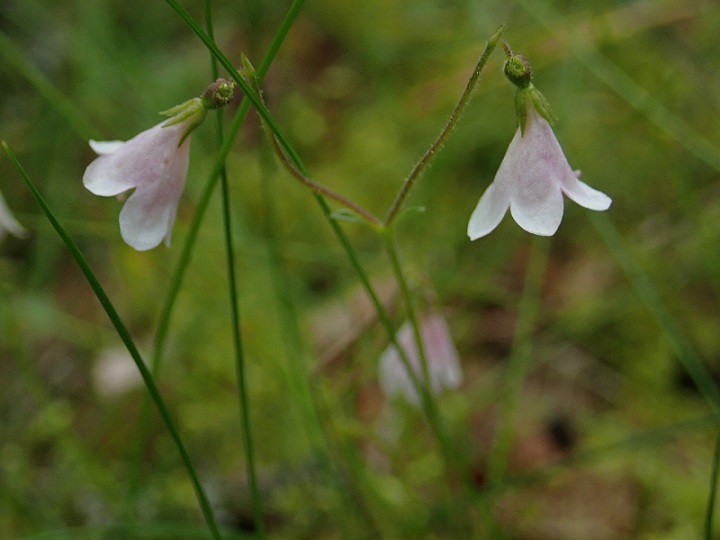
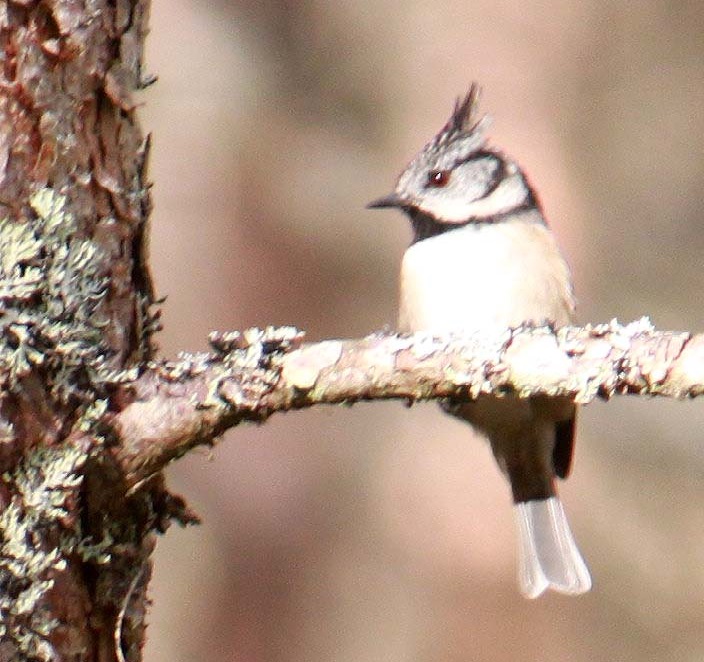
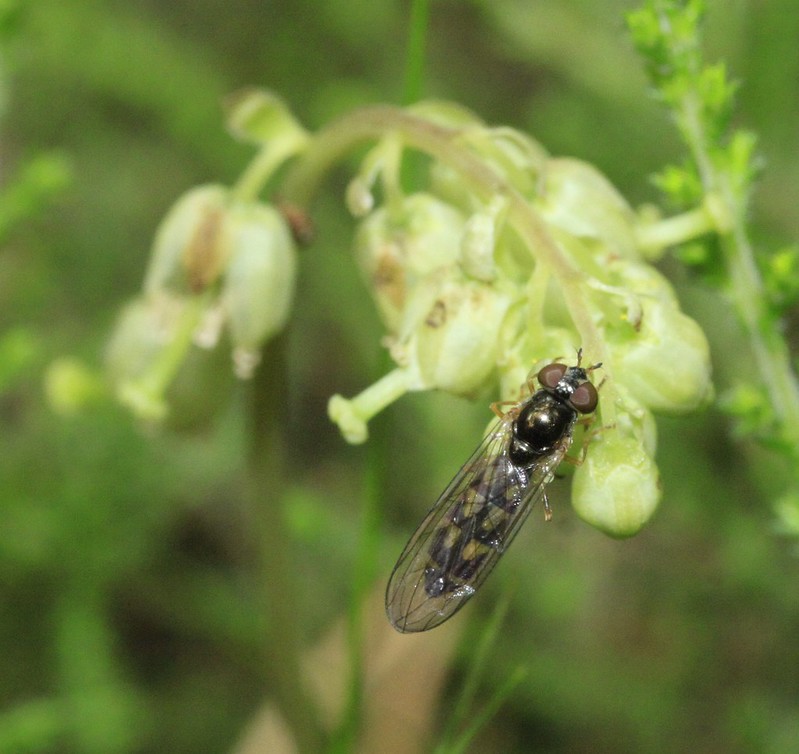
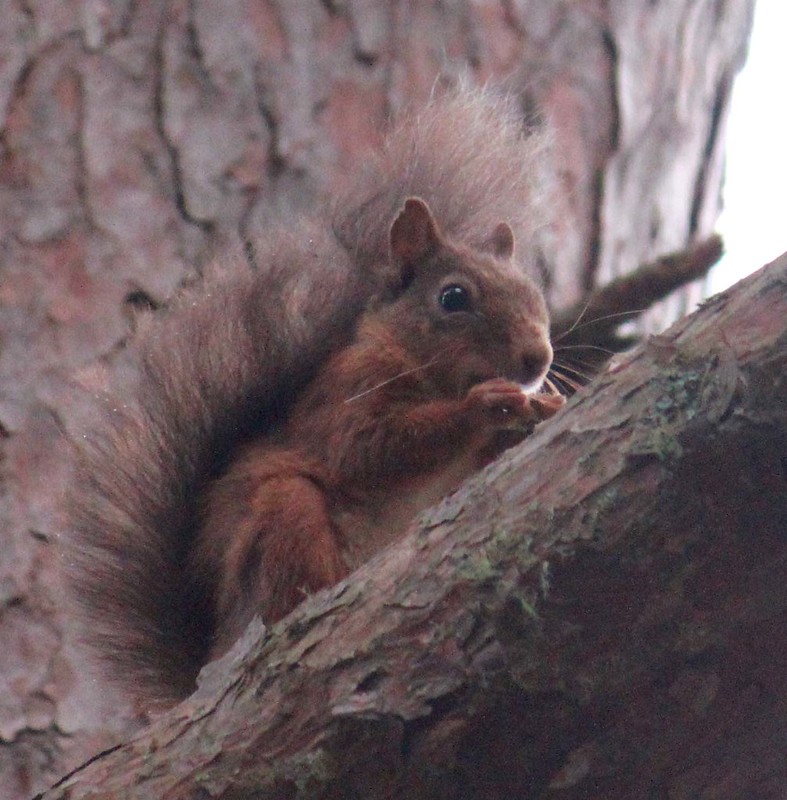

As a consequence of the present Holyrood administration’s attitude towards regional council targets, nearly everything about planning policy across Scotland is now compromised. Setting a target for house building has inspired approval of hundreds unworthy projects across the rural regions . Councillors are further constrained in policy decisions by withheld block grants. There has been a relentless move to complicate the bureaucracy, on often spurious environmental grounds.( Few checks are ever enforced later) The costs of administering the “stakeholder aware” planning process rises exponentially every year, while actual revenue from Council taxes and Council activities has shrunk -relative to inflationary pressures. The disbursement of Public funds to Councils remains tightly circumscribed. So the ‘game of blame’ is shifted from those who create policy at Holyrood to those elected to perform regionally.
Across the Highlands for over 20 years now, there has been a staggering increase in house building. Far too much has happened unremarked except locally. Too often approval has been granted for new build in wholly inappropriate places. Local communities are overruled, planning conditions set to appease them are seldom inspected, and ” as built” alterations too frequently passed without censure. Even when transgressions happen and breaches occur, little force is imposed to restore what has been damaged.( L:ack of funding in councils is cited for this oversight) The conclusion that Councils are so cash “strapped” that they will approve almost anything is not hard to reach. By maintaining numbers at local schools councillors can justify Council services ( rewarded by block grants) and conserve local Council employment. When the only way for Councillors to increase council revenue is new build , and this comes at cost to the environment,. the cost to the environment becomes worth it ? We all know Councillors exist short term. The present “Government” policy is focused on making councils address unreal targets. These are set far to remotely ..against wider financial penalty if they are not met. Can any Rural Planning committee today, backed into this corner by deliberate administrative policy,react correctly ? Rural policy is now generated from within a very narrow Scottish Urban orientated mindset. Local organisations in Scotland who care for the wilder places so future generations may enjoy them are under constant attack by appointed “officials” ? It is doubtful the landscape has much chance to withstand onslaught from such a negligent set of circumstances.
Link sent to Sve Portincaple from Over-Development FB messag, as local residents are fighting to conserve ancient woodland, some already felled by Carrock Castle-based applicant – and Argyll & Bute Planners recommend approval!
Such a shame, this is a lovely bit of woodland or be it part of a larger area. This is part of a long historic pattern where agricultural land is more valued by the landowners than woodland. Presumably in part because of the CAP payments that landowners have harvested. This has ended up in valuable woodland habitats being put forward for development. Woodlands in Carrbridge, Kingussie, Aviemore etc.. have been subject to similar. An area of open land elsewhere in the village is put forward for some compensatory planting, but this doesn’t seem to have universal support for being planted up. Why not build some housing on this land instead of valuable pinewood. There appears to be some weakness in the case being made. Will this compensation planting be delivered? The land is close to the hotel and shop and it would seem to be ripe for development at some point in the future. While I think the proposal should be rejected if the CNPA grant permission they need to be very sure about what compensatory planting they are going to get and exactly how they are going to make the developer deliver it.
I had not objected to this development initially because I had – wrongly – concluded that it had no chance of being recommended for approval, especially given the fact that it has been withdrawn from allocation in the 2020-2025 local development plan that is scheduled for conclusion by the reporters this very month. The actual piece of land by the road was, I believe, a prisoner of war camp in 1945, but that was a very long time ago, and nature has totally taken over once more. The greatest danger is what becomes of the large area of genuine ancient woodland also under control of the developers once they have their approval. I have now written to local board members in Badenoch and Strathspey requesting that they consider the many reasons for refusal very carefully and give them due weight.